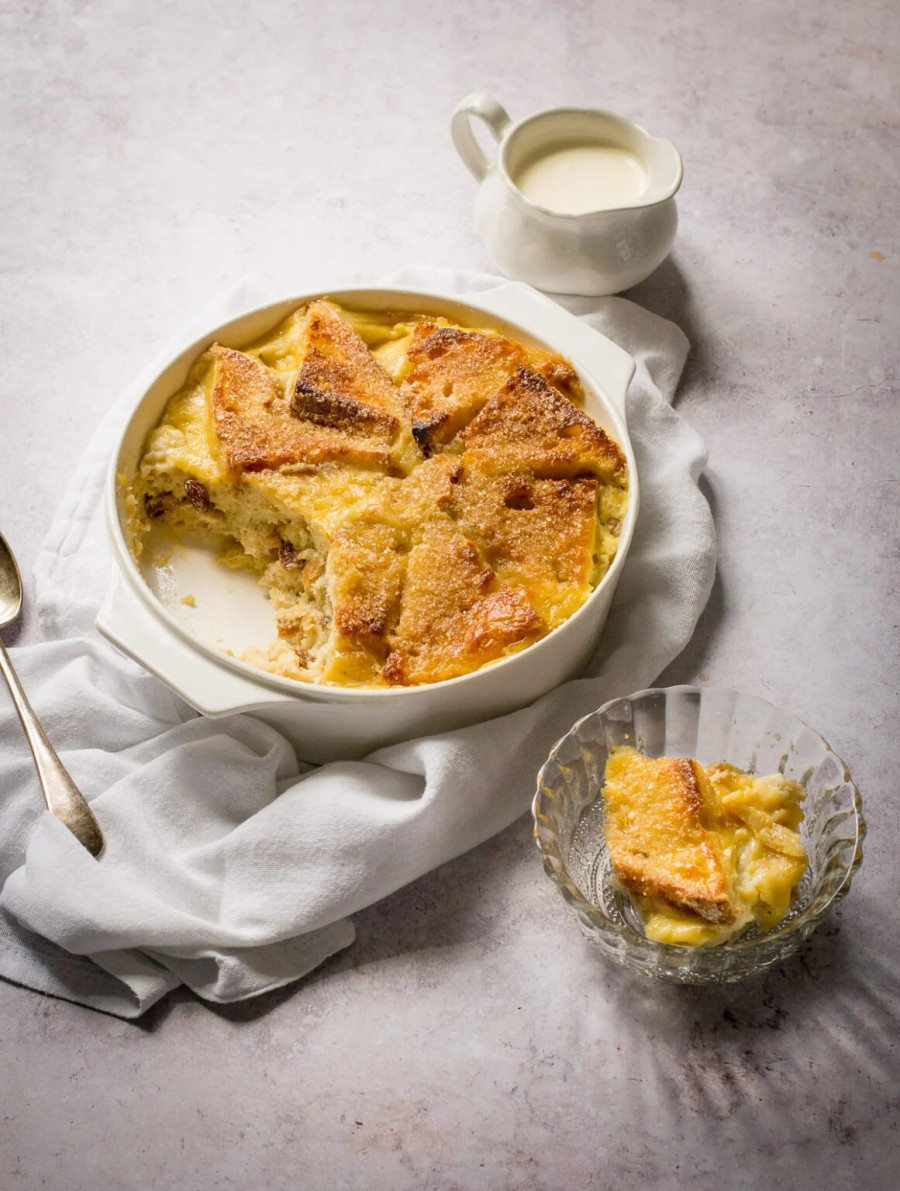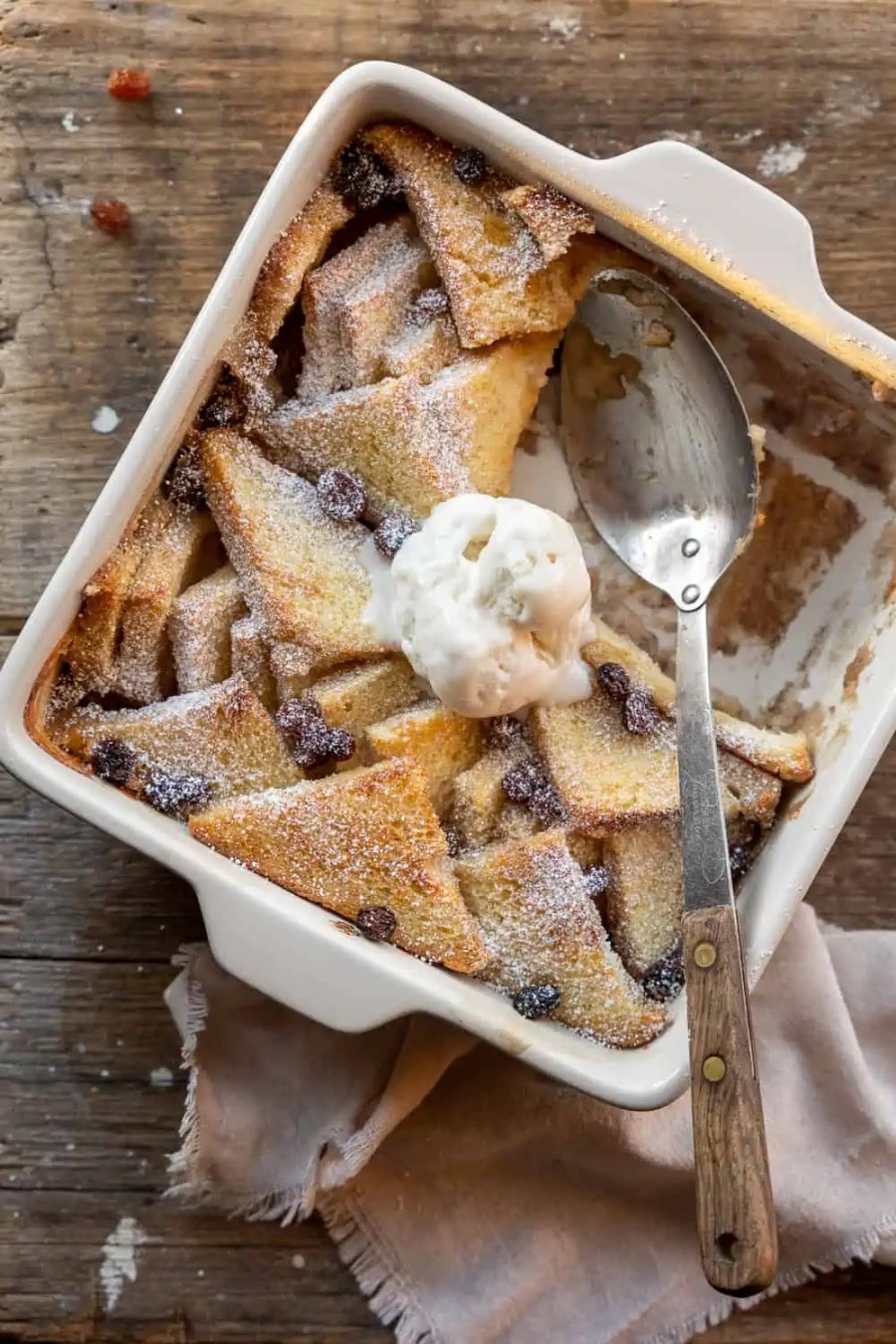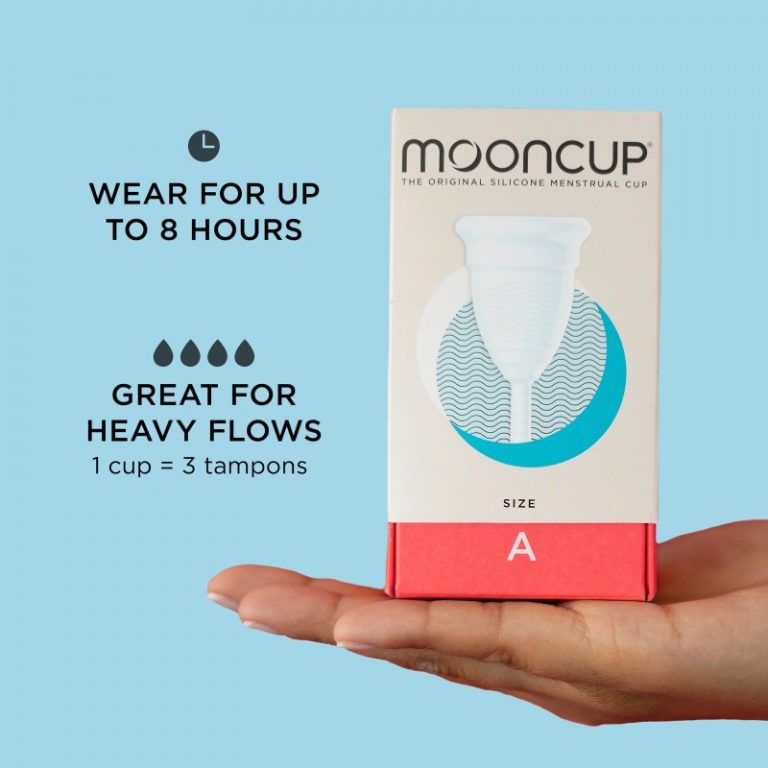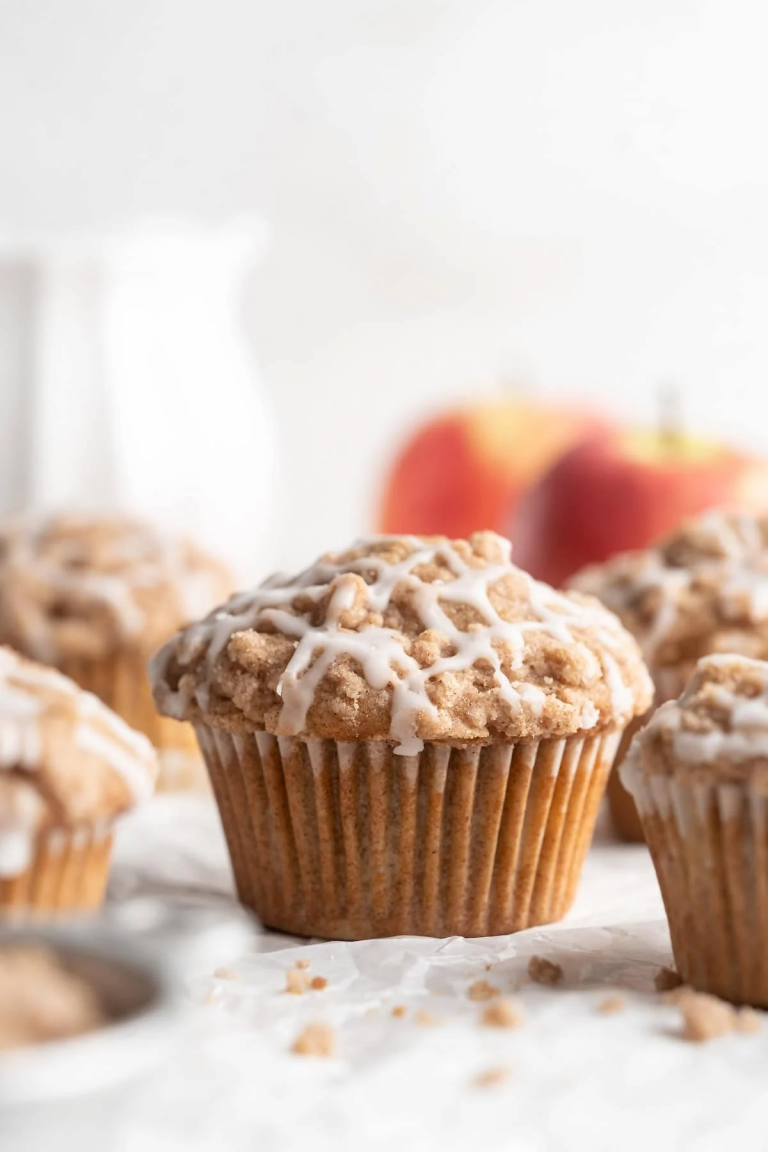
Bread and butter pudding has long been a much-loved dessert, known for its warm, comforting flavours and simple ingredients. Traditionally made with eggs, milk, and butter, the vegan version replaces these with plant-based alternatives without losing its classic charm. Vegan baking is growing in popularity, and making a familiar treat without animal products attracts those seeking both taste and compassion in their kitchen.
This recipe for Bread and Butter Pudding (The Veg Space) is vegan-friendly, and a great way to use up leftover bread. The ingredients (including raisins) are soaked in vegan custard, then topped with demerara sugar. You can even soak dried fruits in sherry or brandy (or fruit juice for a no-alcohol version).
Read our post on food safety for people and pets (fresh bread dough, dried fruits and nutmeg are all toxic to pets. Don’t give stale bread to garden birds or wildfowl, as it could choke (and fatty bread can smear on feathers, affecting waterproofing and insulation).

This zesty bread & butter pudding is from Katy Beskow’s delightful recipe book Five Ingredient Vegan. It uses ready-made vegan custard and marmalade to greatly simplify the recipe.

This vegan bread pudding (Heartful Table) is a delightfully stodgy pudding, created and adapted by a Croatian chef.
Key Differences Between Traditional and Vegan Versions
Classic bread and butter pudding relies on eggs, dairy milk, and butter. These ingredients work together to create a thick, creamy custard that soaks into the bread and holds the layers. In vegan pudding, eggs are left out entirely. Instead, the custard sets using plant-based milks and egg alternatives that rely on starches or tofu. Vegan butter or oils replace dairy butter, making the texture lighter and sometimes a bit different in mouthfeel and flavour.
The biggest change is the custard. Without eggs, the pudding depends on ingredients like flour, cornflour, or coconut cream to give it a rich, silky consistency. This often means the pudding feels a little lighter but no less delicious.
Common Non-Vegan Ingredients and Their Vegan Alternatives
Here’s a quick look at what gets swapped out and what you use instead:
- Eggs:
Replace with mashed banana, silken tofu, egg replacer powders, or flaxseed mixed with water. These options help bind the pudding and add smoothness to the custard. - Milk:
Swap dairy milk for oat, almond, soy, or coconut milk. Choose unsweetened versions if you want to control the sweetness, or go for creamy coconut milk if you want a richer taste. - Butter:
Use vegan margarine or coconut oil as a straight substitute. Vegan butter keeps the familiar buttery flavour and helps the bread soak up deliciousness.
Choosing the Right Bread for Vegan Pudding
Not all bread is created equal when it comes to pudding. The ideal bread holds up well to soaking without falling apart completely. Thick, rustic loaves with some density work best. Think simple white or wholemeal bread, brioche (vegan varieties are available online or in stores), or even sourdough.
Bread texture and flavour have a big impact:
- Dense bread gives a hearty pudding with a good bite.
- Soft bread soaks up custard quickly and produces a creamier texture.
- Sweet breads like fruit loaf add extra flavour without needing many add-ons.
Avoid bread with heavy seeds or thick crusts if you want a smooth, traditional texture.
Natural Sweeteners and Flavour Enhancers
Sugar often sneaks into vegan recipes, but some versions steer clear of refined sugar. Natural sweeteners work well in vegan puddings and bring extra depth:
- Maple syrup adds warm, caramel notes.
- Agave nectar has a mild flavour and blends seamlessly.
- Coconut sugar gives a slight molasses taste and browns the pudding.
- Date syrup offers rich, earthy sweetness with added nutrients.
For an extra flavour boost, vanilla extract, ground cinnamon, nutmeg, or freshly grated citrus zest can brighten up the dish. These spices work perfectly to lift the natural flavours without overwhelming the pudding.
Understanding these ingredients and how they work together gives you the confidence to make a vegan bread and butter pudding that’s just as comforting and tasty as the original. The key is to focus on texture and balance, so every bite feels like the classic you love—just without the animal products.
Classic Vegan Bread & Butter Pudding
This recipe sticks to the essentials. It uses staple vegan ingredients and a hint of vanilla that gives a warm, comforting flavour just like the traditional version.
Ingredients:
- 8 slices of vegan-friendly white or wholemeal bread, buttered with vegan spread
- 500ml unsweetened oat or soy milk
- 150ml coconut cream or any thick plant-based cream
- 75g caster sugar or maple syrup
- 2 tsp vanilla extract
- 3 tbsp cornflour mixed with 4 tbsp cold water
- A pinch of salt
- Optional: raisins or sultanas
Instructions:
- Preheat the oven to 180°C (160°C fan).
- Layer the buttered bread slices in a baking dish, adding raisins between layers if you like.
- In a saucepan, heat the plant milk, cream, sugar, vanilla, and salt until warm but not boiling.
- Slowly whisk in the cornflour slurry and keep stirring until the mixture thickens lightly.
- Pour the custard over the bread, pressing gently to soak.
- Leave to stand 10 minutes, then bake for 30-35 minutes until golden and set.
- Serve warm or cold with vegan custard or cream.
This recipe is a great base and offers the tender, creamy pudding flavour you expect, with the comfort of vanilla and gentle sweetness.
Tips and Techniques
Making vegan bread and butter pudding that turns out just right takes some attention to detail. With plant-based ingredients, the texture and flavour can shift a bit, so a few simple tricks help you get that soft, custardy middle with a golden, slightly crisp top every time. From preparing your bread to choosing the best custard mix and baking correctly, these tips will guide you toward pudding perfection.
Preparing the Bread: Toasting and Buttering
The bread is the backbone of your pudding, so how you treat it matters a lot. Start by choosing slices that are fresh but firm. If your bread is too soft, it will turn mushy when soaked; stale bread is often perfect because it holds custard better.
Before layering, lightly toast the bread slices. This extra step helps create a firmer exterior so the custard doesn’t soak in too quickly and cause sogginess. Even a quick 2-3 minute toast under a grill or in a toaster works well.
Next, generously butter each slice with vegan butter or margarine. This adds flavour and creates a barrier that stops bread from getting overly saturated too fast. Don’t be shy about this step; it’s key for balancing the creaminess with a pleasant texture. Use a plant-based butter that melts easily and leaves a subtle richness.
Choosing the Right Plant Milk and Egg Alternatives
The custard sets the texture and binds your pudding, so picking the right milk and egg substitutes matters. Thick, creamy plant milks work best because they replicate dairy’s smoothness better than watery ones.
Here are some good choices:
- Oat milk: Thick, naturally sweet, and creamy without overpowering other flavours. Unsweetened works well if you want control over sweetness.
- Full-fat coconut milk: Adds richness and a faint coconut note, ideal if you enjoy tropical flavours.
- Soy milk: Neutral and creamy, it’s likely to give the traditional custard feel.
- Almond milk: Lighter in texture but still good when combined with a thickener like cornflour or silken tofu.
For egg replacements, silken tofu and flaxseed mixed with water are popular. Tofu melts into the custard for creaminess without overpowering taste, while flaxseed gel adds some body and acts as a binder. If you want a thicker set, cornflour or plain flour mixed with cold water creates that custard-like gel when cooked gently.
Baking Temperatures and Times for Ideal Texture
Getting the cooking temperature and timing right is crucial. Too high, and the custard will dry out or curdle; too low, and the pudding won’t set properly or may take ages.
- Set your oven to 180°C (160°C fan) for an even, gentle bake that cooks through without burning.
- Bake for 30 to 40 minutes depending on your oven and pudding depth. If it looks too wet on top around 30 minutes, give it 5-10 more minutes, checking often.
- The pudding is done when the top is golden and a little crisp, and the custard feels just firm when nudged in the centre. It should hold its shape but still be soft.
- Let the pudding rest to thicken further as it cools. This also helps flavours settle.
Avoiding Common Issues: Sogginess and Overcooking
Vegan bread and butter pudding tends to get soggy or overly dry if you’re not careful. Here is how to avoid those traps:
- Prevent sogginess by toasting the bread and buttering it well before soaking. Don’t pour custard all at once; pour a little, press gently into the bread, then layer and pour remaining custard. This helps bread soak gradually and evenly.
- Don’t over-soak before baking. Leave it to rest about 10 minutes so custard sinks in, but don’t let it sit too long or bread will become mushy.
- Keep an eye on baking time. Overbaking will dry out the custard and crumbly texture. If the top browns too quickly, cover loosely with foil.
- Use a shallow baking dish to encourage quicker, even baking.
Storage and Reheating Tips for Best Quality
If you have leftovers, you can store them well:
- Keep pudding covered in the fridge for up to 3 days. The flavours will often deepen overnight.
- To reheat, place the pudding in an ovenproof dish and warm at 160°C (fan) for 10-15 minutes until heated through. Cover with foil if the top starts to brown too much.
- Alternatively, microwave individual slices on medium power for 1 to 2 minutes, though the texture won’t be quite as good as oven reheating.
- For longer storage, wrap tightly and freeze. Thaw overnight in the fridge, then warm gently in the oven.
These small but important tips will help your vegan bread and butter pudding keep its comforting softness and avoid the dreaded soggy or dry texture that can happen with plant-based baking. Following these steps will let you enjoy a pudding that feels expertly crafted without fuss or guesswork.
Sourcing Ingredients and Vegan Alternatives
Making a great vegan bread and butter pudding starts with finding the right ingredients. The quality and type you choose shape the flavour, texture, and overall success of your dish. Luckily, plant-based options for milk, butter, eggs, and sugar have become widely available, making it easier than ever to bake vegan without compromising taste. Knowing where to shop and how to read labels ensures you pick products that are truly vegan and suitable for your recipe.
Finding Dairy-Free Butter and Plant-Based Milks
Dairy-free butter is key to achieving that rich, buttery flavour and tender crumb in your pudding. Look for vegan margarines or spreads made from vegetable oils, coconut, or a blend that melts smoothly. Many brands now highlight “vegan” clearly on the packaging. Check the ingredient list to avoid any added dairy or casein.
When it comes to plant milks, the choice often depends on your flavour and texture preference:
- Oat milk offers creaminess and a slightly sweet profile, great for custards that need thickness.
- Soy milk is neutral with a mild bean taste and tends to be sturdier when heated.
- Coconut milk (full fat) brings richness and a subtle coconut aroma that pairs well with tropical or spiced puddings.
- Almond milk is lighter and works well if combined with a thickening agent.
Most supermarkets stock these milks in both fresh and long-life formats, so you can keep supplies handy. Organic options are also becoming affordable and convenient.
Egg Replacers: What Works Best and Where to Buy
Replacing eggs in custard can feel tricky, but you have solid choices that bind and thicken well.
- Flaxseed meal mixed with water: Found in health food stores and larger supermarkets, this is an easy, affordable option that gels nicely.
- Silken tofu: Widely available fresh or in shelf-stable packs, tofu blends smoothly into custards for a creamy texture without altering flavour.
- Commercial egg replacer powders: Brands like Ener-G and Orgran often sell these online and in specialist stores. They are neutral in taste and simple to measure out.
- Aquafaba: The liquid from canned chickpeas, which whips and thickens like egg whites, though less common in puddings.
Check product labels for any hidden animal ingredients, as some egg substitutes might blend starches with dairy or honey.
Choosing Vegan Sugars and Sweeteners
Not all sugars are vegan-friendly because some use bone char in processing. Look for labels stating “organic,” “raw,” or “unrefined,” as these are almost always vegan. Popular vegan sugars include:
- Coconut sugar: Adds a mild caramel taste and browns well.
- Maple syrup: A natural sweetener with a distinctive flavour, ideal for richer puddings.
- Agave nectar and date syrup: These are great liquid options that dissolve quickly and impart subtle sweetness.
Buying sugars and syrups in bulk at health food shops or online often saves money. Storing sugar in an airtight container keeps it fresh for longer.
Choosing Sustainable and Seasonal Ingredients
Opting for seasonal and local ingredients not only supports your local economy but also reduces environmental impact. Fresh fruits like apples or berries during their peak season enhance your pudding naturally without needing extra flavourings.
Sustainable brands for plant milks and vegan butter are becoming more common. Look for those with minimal packaging or recyclable containers. Some make efforts to source ingredients responsibly, which is worth prioritising when you can.
Choosing affordable brands alongside sustainable options is possible by mixing staples with special treats. For example, a basic oat milk works well for the custard, while a small amount of full-fat coconut milk brings richness.
By knowing where and how to source the right vegan ingredients, your bread and butter pudding will shine with both flavour and care. It’s easier than ever to bake with confidence while sticking to your values and budget.






